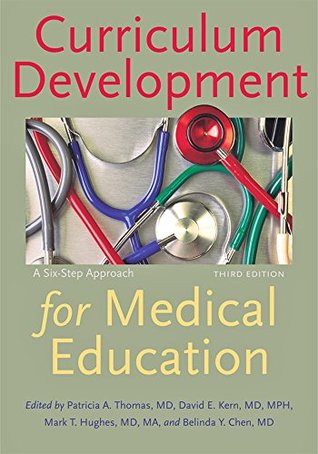Kindle Notes & Highlights
Read between
October 1, 2018 - May 17, 2019
Practice patient-centered care (4, 5).
Routinely assess and improve their own practice (practice-based learning and improvement, or PBLI) (8, 9).
Current trends in translating competencies into clinical practice, such as entrustable professional activities (EPAs) (14, 15) and observable practice activities (OPAs) (16
identification and critical analysis of a health care need or other problem.
specific health problem,
group of problems,
qualities of the physician,
health care needs of society in general,
analysis of the current approach of patients, practitioners, the medical education system, and
identification of an ideal approach
starting with broad or general goals and then moving to specific, measurable objectives. Objectives may include cognitive (knowledge), affective (attitudinal), or psychomotor (skill and behavioral) objectives for the learner;
Why is a new or revised curriculum worth the time and effort needed to plan and implement it well? Since the ultimate purpose of medical education is to improve the health of the public, what is the health problem or outcome that needs to be addressed? What is the ideal role of a planned educational experience in improving such health outcomes?
identify and characterize the health care problem that will be addressed by the curriculum, how the problem is currently being addressed, and how it ideally should be addressed. The difference between how the health care problem is currently being addressed, in general, and how it should be addressed is called a general needs assessment.
A comprehensive definition of the problem should consider the epidemiology of the problem, as well as the impact of the problem on patients, health care professionals, medical educators, and society (Table 2.1).
Whom does it affect? Patients Health care professionals Medical educators Society What does it affect? Clinical outcomes Quality of life Quality of health care Use of health care and other resources Medical and nonmedical costs Patient and provider satisfaction Work and productivity Societal function What is the quantitative and qualitative importance of the effects?
The process of determining the current approach to a problem is sometimes referred to as a “job analysis” because it is an assessment of the “job” that is currently being done to deal with a problem
what is being done by each of the following: a. Patients (including their families, significant others, and caregivers) b. Health care professionals c. Medical educators d. Society (including community networks, health care payers, and policymakers)
Much can be learned from the previous work of educators who have tried to tackle the problem of interest.
Table 2.2. The General Needs Assessment What is currently being done by the following? Patients Health care professionals Medical educators Society What personal and environmental factors affect the problem? Predisposing Enabling Reinforcing What ideally should be done by the following? Patients Health care professionals Medical educators Society What are the key differences between the current and ideal approaches?
ecological perspective on human behavior. This perspective emphasizes multiple influences on behavior, including at the individual, interpersonal, institutional, community, and public policy levels
Predisposing factors refer to people’s knowledge, attitudes, and beliefs that influence their motivation to change (or not to change) behaviors related to a problem. Enabling factors generally refer to personal skills and societal or environmental forces that make a behavioral or environmental change possible. Reinforcing factors refer to the rewards and punishments that encourage continuation or discontinuation of a behavior.
The process of determining the ideal approach to a problem is sometimes referred to as a “task analysis,” which can be viewed as an assessment of the specific “tasks” that need to be performed to appropriately deal with the problem
A curriculum, therefore, may choose to address current societal factors that contribute to or alleviate a problem (such as advertisements, political forces, organizational factors, and government policies).
it is useful to be transparent about the basis for one’s “ideal” approach: individual opinion, consensus, the logical application of established theory, or scientific evidence.
Table 2.3. Methods for Obtaining the Necessary Information Review of Available Information Evidence-based reviews of educational and clinical topics Published original studies Clinical practice guidelines Published recommendations on expected competencies Reports by professional organizations or government agencies Documents submitted to educational clearinghouses Curriculum documents from other institutions Patient education materials prepared by foundations or professional organizations Patient support organizations Public health statistics Clinical registry data Administrative claims data
...more
The Best Evidence in Medical Education (BEME) Collaboration is a good source of high-quality evidence-based reviews of topics in medical education


